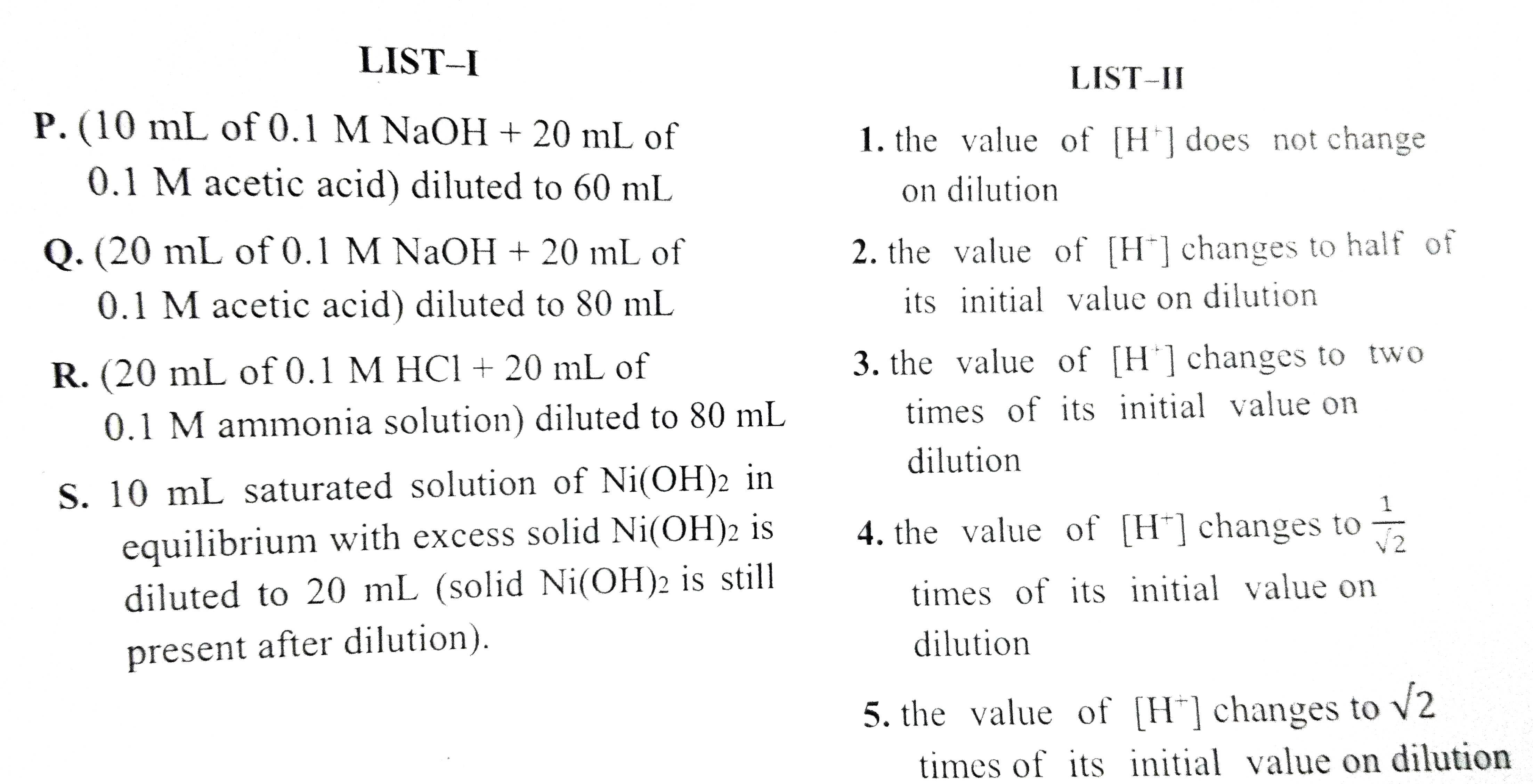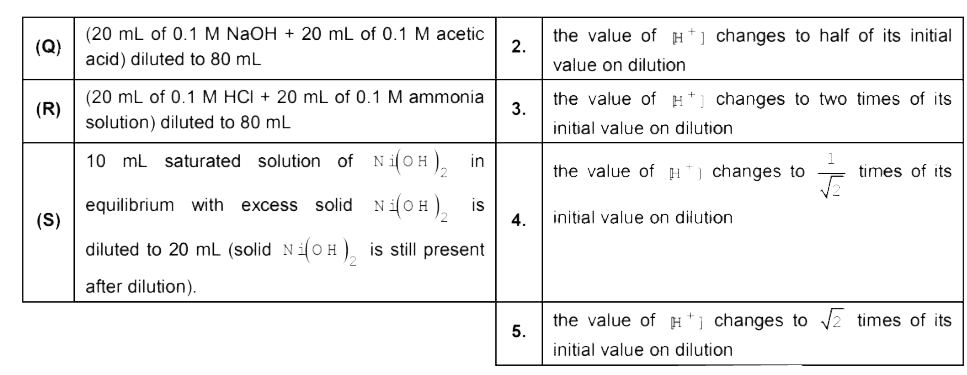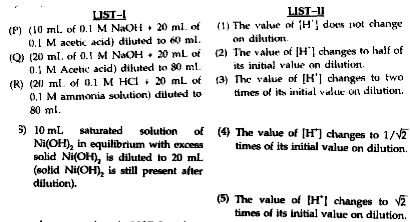Dilution process of different aqueous solution , with water are given in List-I. The effects of dilution of the solutions on [H+] are given in List-II. (Note : Degree of dissociation (α) of weak acid and weak base is ltlt 1, degree of hydrolysis of salt <<1,[H+] represents the concentration of H+ ions)
∣∣
∣
∣
∣
∣
∣
∣
∣
∣
∣
∣
∣
∣
∣
∣
∣
∣∣ List-I List -II(P)(10 mL of 0.1 M NaOH+20 mL of 0.1 acetic acid)dilutes to 60 mL(1)The value of [H+] does not change on dilution(Q)(20 mL of 0.1 M NaOH + 20 mL of 0.1 M acetic acid)diluted to 80 mL(2)The value of [H+] change to half of its initial value on dilution(R)(20 mL of 0.1 M HCl + 20 mL of 0.1 M ammonia solution)diluted to 80 mL(3)The value of [H+] change to two times of its initial value on dilution(S)10 mL saturated solution of Ni(OH)2 in equilibrium with excess solid Ni(OH)2 is (4)The value of [H+] changes to 1√2 times of its initial value on dilutiondiluted to 20 mL (solid Ni(OH)2 is still present after dilution)(5)The value of [H+] changes to √2 times of its initial value on dilution∣∣
∣
∣
∣
∣
∣
∣
∣
∣
∣
∣
∣
∣
∣
∣
∣
∣∣
The correct Answer is:P→1;Q→5;R→4;S→1
P→1,Q→5,R→4,S→1
P. CH3COOH0.1M, 20ml+NaOH0.1M, 10ml→CH3COONa+H2O
pH=pKa⇒[H+] will not change on dilution correct match : F - 1
Q. CH3COOH0.1M, 20ml+NaOH0.1M, 20ml→CH3COONa+H2O − − 0.05M
[OH−]=√KHC=√(kwkaC)
[H+]1=√kwkaC
[H+]2[H+]1=√C1C2=√0.050.025=√2
Correct match : Q-5
R. NH4OH0.1M, 20ml+HCl0.1M, 20ml→NH4Cl0.05M
[H+]=√KHC
[H+]2[H+]1=√C2C1=1√2
Correct match : R-4
S. Because of dilution solubility does not change so [H+] = constant.
Topper's Solved these Questions
- SOLUTION BOOK - ERRORLESS CHAPTER - SOLUTION EXERCISE - JEE SECTION (Matrix Match type questions)
1 Video
- SOLID STATE BOOK - ERRORLESS CHAPTER - SOLID STATE EXERCISE - JEE section (Numeric )
1 Video
- SOME BASIC CONCEPTS OF CHEMISTRYBOOK - ERRORLESS CHAPTER - SOME BASIC CONCEPTS OF CHEMISTRYEXERCISE - JEE Section (Matrix Match type questions)
3 Videos
Similar Questions
Dilution processes of different aqueous solutions, with water, are given in LIST-I. The effects of dilution of the solutions on [H+] are given in LIST-II. (Note: Degree of dissociation (α) of weak acid and weak base is << 1, degree of hydrolysis of salt <<1,[H+] represents the concentration of H+ ions)

View SolutionDilution processes of different aqueous solutions, with water, are given in LIST-I. The effects of dilution of the solutions on [H+]. are given in LIST-II.(Note: Degree of dissociation (α) of weak acid and weak base is<<1, degree of hydrolysis of salt <<1, [H+] represents the concentration of [H+] ions)
Match each process given in LIST-I with one or more effect(s) in LIST-II. The correct option is

View Solution
Knowledge Check
Dilution processes of different aqueous solutions with water are given in LIST-I. The effect of dilution of the solution on [H+] are given in List =II.
 AP-4, Q-2, R-3, S-1BP-4, Q-3, R-2, S-3CR-1, Q-4, R-5L S-3DP-1, Q-5, R-4, S-1
AP-4, Q-2, R-3, S-1BP-4, Q-3, R-2, S-3CR-1, Q-4, R-5L S-3DP-1, Q-5, R-4, S-1The degree fo hydrolysis for a salt of strong acid and weak base
AIs independent of dilutionBIncreases with dilutionCIncreases with decrease in Kb of the baseDDecreases with decrease in temperatureFor the aqueous solution of a salt of a weak acid abd a weak base,
AKh=√h1−hB√Kh=h21−hC√Kh=h1−hDKh=h1−h
Show that the degree of hydrolysis of a salt of weak acid and weak base is independent of concentration of the salt.
View SolutionDegree of hydrolysis for a salt of strong acid and weak base:
View SolutionA salt of strong acid and weak base is dissolved in water. Its hydrolysis in solution is
View SolutionThe degree of hydrolysis of a salt of weak acid and weak base in its 0.1 M solution is 0.2 M, the precentage hydrolysis of the salt should be
View SolutionThe degree fo hydrolysis for a salt of strong acid and weak base
View Solution
